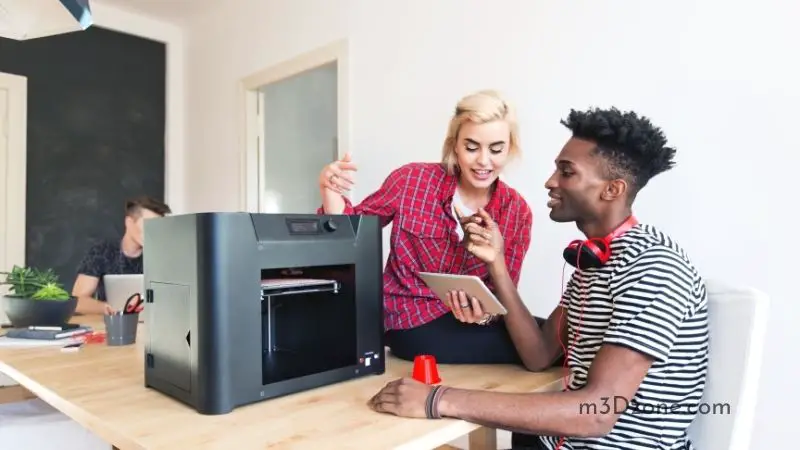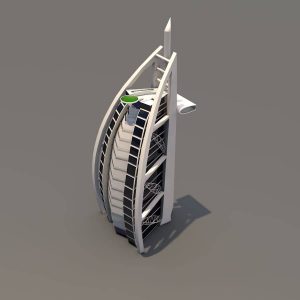Technology plays an essential role in changing how people conduct their business at home and in their workplaces, cutting across different industries.

As an Amazon Associate, I earn from qualifying purchases. If you make a purchase after clicking on a link I may earn a small commission at no extra cost to you.
Also, the education industry experience changes spearheaded by technological advancement. Let’s find out how educational 3D printing can help students and teachers.
For instance, the traditional lesson plan proves tiresome to students as learning remains confined to classroom use. Younger students prefer to learn while playing, and older students get excited with stem learning.
Quick Navigation
- What Is Educational 3D Printing?
- How Can 3D Printing Be Used in Education?
- Why Is 3D Printing Important in Education?
- What Type of 3D Printers Are Used in Schools?
- School-Based 3D Printers
- How to Use a 3D Printer in the Classroom
- Why Are3D Printers Good for Schools?
- What Are Some Real World Problems 3D Printers Are Solving?
- Conclusion
The world keeps changing, so the education curriculum development process changes. Therefore, to prepare students for a career in either engineering or 3D software design, schools use the best 3D printers for teaching students and introducing them to stem education.
3D printing education offers students in primary and secondary schools unique learning opportunities that focus on stem concepts.
These learning opportunities come up in a broad area of subjects taught in mathematics, technology, science, arts, and engineering.
3D printing in education can bring life to any curriculum development as it helps students build skills like problem-solving, design, and creative coding.
What Is Educational 3D Printing?
What Is 3D Printing?
3D printing or additive manufacturing is the process of making an object from a three-dimensional digital model. Additionally, it occurs when the 3D printer layers down many layers of molten plastic in succession and lets it cool down into a solid object.
Educational 3D Printing
In short educational 3D printing refers to using the new technologies in 3D printing explicitly designed to help students learn.
The application of 3D printing provides students with numerous benefits that cut across primary and secondary schools, libraries, colleges, and universities.
Manufacturers and educators leverage 3D printing technologies in their ways. More importantly, 3D printing makes education more exciting and transforms schools and classrooms to look like engineering research centers.
Additionally, 3D printing facilitates improve student/teacher engagement with the subject.
Thus, it improves student learning, enables greater creativity, and enhances collaboration in problem-solving.
How Can 3D Printing Be Used in Education?
It provides a variety of uses in schools and other educational settings. Interestingly, 3D print models do not print with ink but with plastic, rubber, and metal materials.
3D printers remain pretty affordable and easy to use, making them a big hit with children in school. Also, students of all grades enjoy the educational benefits of 3D printing as course outlines, encourage practical 3D printing lessons.
Furthermore, 3D printing and technology enjoy excellent traction among students because their use keeps varying as it develops.
However, the real benefit of 3D printing remains in the burst of creativity and imagination it creates in chemistry, biology, and architecture, among other fields of study.
Curriculum Development
3D printing plays a significant role in the development of modern-day schools, colleges, and university curriculum. Most of these educational settings appreciate the need to incorporate technology in their curriculums.
Technology makes learning fun- like, and teachers and educators agree that they engage enthusiastic students.
Unlike the traditional curriculum, the practical lesson seems so engaging to students, unlike the previous curriculum which emphasizes paperwork, theories, and passing exams.
Teaching Students In Class And Online Courses
Teachers and educators use 3D printing technology to provide their students with accurate prototypes. Also, these prototypes help teachers provide students with practical hands-on lessons that offer knowledge in understanding scientific concepts.
Additionally, when students use 3D printed models for lesson demonstrations, it significantly helps improve their public speaking skills.
Educators use 3D printed visualizations to improve their education lessons significantly.
Teachers enjoy using 3D printing technology as their students remain engaged and excited throughout the lesson. Some get lost in fun, not knowing they learn valuable lessons on theory, design, and manipulation.
Online classes remain enjoyable and exciting as the teacher spends most of the lesson engaging students using practical applications of 3D printing to unravel the intricate and complex aspects of the lesson’s concept.
Why Is 3D Printing Important in Education?
3D printing technology creates learning excitement in schools and other educational institutions. Students of all grades enjoy learning using 3D printers. This remains a complete departure from the standard classroom setup.
Additionally, 3D printing seamlessly complements the existing school curriculums making learning shift from theory-based learning to practical-oriented learning.
3D printers provide learning opportunities to students in knowledge areas unavailable to them in the recent past. 3D printing allows students to grow their creative skills.
Moreover, it provides them with the opportunity to use this originality and creativity in business applications later in life.
In learning how to troubleshoot and solve problems, students practice the virtue of persistence and endurance in overcoming difficulties. It enables them to help other students and also solve their problems.
3D printing continues to gain traction in educational setups as it helps students develop the confidence they need to transit to college and university. Moreso, it provides the students with the passion and ability to pursue challenging college courses like STEM.
As students keep using the 3D printer, their confidence and imagination grow. So, they cultivate the capacity for innovation that enables them to create their 3D projects.
Educators and students use these projects to train other students and also solve pertinent challenges.
In essence, 3D printing in education helps students dream bigger practicing these skills in their future careers after school.
What Type of 3D Printers Are Used in Schools?
Increasingly, 3D printers are becoming the teacher’s most potent innovative tool to spark creative learning in schools. It enables previously perceived difficult and tedious science classes to come to life with the vast practical activities that it provides.
3D printing offers students a unique experience in STEM subjects like Arts, mathematics, and Engineering. Some 3D printer manufacturers offer products together with support material for teachers.
The support material includes lesson plans that make lessons inspiring and fun while remaining structured enough to meet specified goals.
Other manufacturers strive to produce 3D printers with all the necessary features teachers and students may need in a classroom 3D printer.
School-Based 3D Printers
-
Robo C2
- Technology: FDM
- Heated Platform: No
- Suitability: Elementary and High School
- Educational Resource: Yes
-
Dremel Digilab 3D45 Idea Builder
- Technology: FDM
- Heated Platform: Yes
- Suitability: Elementary and High School
- Educational Resource: Yes
-
Flashforge Finder
- Technology: FDM
- Heated Platform: No
- Suitability: Elementary and High School
- Educational Resource: No
-
XYZ Printing da Vinci Jr Pro 1.0
- Technology: FDM
- Heated Platform: No
- Suitability: High School and College
- Educational Resource: Yes
-
Sculpto+
- Technology: FDM
- Heated Platform: No
- Suitability: Elementary and High School
- Educational Resource: No
-
Tiertime Up Mini 2ES
- Technology: FDM
- Heated Platform: Yes
- Suitability: Elementary and High School
- Educational Resource: No
-
Ultimaker Original+
- Technology: FDM
- Heated Platform: Yes
- Suitability: Elementary and High School
- Educational Resource: Yes
How to Use a 3D Printer in the Classroom
3D printers have become the catalyst for learning processes in schools. Also, it remains a major revolutionary technology that helps educators achieve an extraordinary level of engagement with students.
Teachers and students can use 3D printers to create interactive maps in the classroom. They can create real-life maps of renowned cities such as Paris or historical sites such as the Roman settlements.
The students may even stretch their imagination by drawing how the modern cities will look in the future or the towns they read in books.
3D printing can be used, especially by kids, to create decorations of their choice. In comparison, older students may re-create real-life structures like Dubai’s world-famous Al-Jumeirah Hotel.

https://free3d.com/3d-model/burj-al-arab-jumeirah-3d-modeling-in-cinema-4d-designing-937357.html
Teachers may ask students to create job tools or even musical instruments of their choice depending on the subject being taught.
3D printers allow students to learn in many ways. For example, a teacher may ask students to create a human skeleton or the body’s internal organs, such as the heart. Additionally, during a History lesson, students may be asked to create a dinosaur.
Why Are3D Printers Good for Schools?
3D printing technology remains a welcomed technology in schools and educational places as it offers several benefits to both educators and learners.
First, the technology promotes active student participation in the classroom as the lessons remain practically oriented as opposed to textbook reading. Thus, it provides the students with a dynamic learning environment, making learning enjoyable.
Also,3D printers encourage creative thinking and increase the student’s problem-solving skills.
3D printing helps students and teacher engagement become better, and this helps increase the student’s retention rate in school.
Furthermore, the 3D printing lessons help students develop the careers they would want in the future. So, it turns subjects into real-life jobs.
What Are Some Real World Problems 3D Printers Are Solving?
3D printing technology provides an opportunity to solve numerous real-life challenges that people face in modern times.
It can be used to create replacement parts for household products or manufacturing machine spare parts.
Also, you may want to 3D print helpful personal items and in an individual specification.
3D printing revolutionalized the manufacturing industry. It enables various applications like machine manufacture, spare parts creation, product design that help its industry-based applications to thrive.
It came in handy during the creation of prototypes. Most industries find it helpful and easy to create product prototypes using this technology. Thus, they can test the prototype’s viability in terms of strength and durability before engaging in mass product production.
Additionally, people can use 3D printers to create musical instruments or circular product designs.
Professionals apply 3D printing technology in manufacturing industries. Interestingly, today, even houses and buildings can be created using 3D printing technology.
Conclusion
3D printing technology revolutionalized the way learning takes place in schools, colleges, and universities. Also, the technology provides educators and students with an opportunity to engage more compared to the textbook days.
3D printing serves as a catalyst that helps teachers pass knowledge to students better than the days when they depended only on teaching aids like flip charts.
It helps students relate to what they learn in the classroom and the careers they may want to take later in life.
Furthermore, it helps students learn in a fun-like environment, removing the boredom of traditional classroom learning.
Recommended Reading
PETG Bridging. Issues, Settings, and Easy Fixes!
What is PETG bridging in 3D printing? It is an extrusion of material between two raised areas of a printed object in 3D without support from below. Let'see!
3D Printer Retraction Length & Speed! Recommended Settings.
3D printer retraction settings refer to the speed and length in which the nozzle pulls back the excess filament within the extrusion system. Let's see!
9 Best 3D Printing Software for Beginners [Useful Guide]
A 3D printer needs a good 3D printer software. Here's our 9 picks of the best 3D printing software for beginners to help point you in the right direction.





